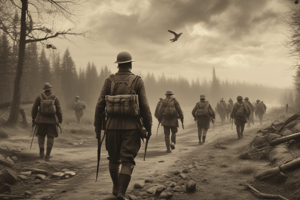Podcast
Questions and Answers
Which two coalitions fought against each other in World War I?
Which two coalitions fought against each other in World War I?
- The Allies and the Triple Entente
- The Allies and the Axis Powers
- The Allies and the Central Powers (correct)
- The Allies and the Triple Alliance
Where did the fighting take place during World War I?
Where did the fighting take place during World War I?
- Only in the Middle East
- Only in Europe
- In multiple regions across the world (correct)
- Only in Africa
What event triggered the start of World War I?
What event triggered the start of World War I?
- The invasion of Poland
- The assassination of Archduke Franz Ferdinand (correct)
- The signing of the Treaty of Versailles
- The bombing of Pearl Harbor
Which country declared war on Serbia, starting World War I?
Which country declared war on Serbia, starting World War I?
What was the initial German strategy in 1914 during World War I?
What was the initial German strategy in 1914 during World War I?
Flashcards are hidden until you start studying
Study Notes
World War I
- The two main coalitions that fought against each other in World War I were the Allies (which included countries such as France, Britain, and Russia) and the Central Powers (which included countries such as Germany, Austria-Hungary, and the Ottoman Empire).
Theaters of War
- Fighting during World War I took place on several fronts, including the Western Front in France and Belgium, the Eastern Front in Russia, the Italian Front in Italy, and the Balkans Front in Serbia and Greece.
Causes of the War
- The assassination of Archduke Franz Ferdinand of Austria-Hungary by a Serbian nationalist in Sarajevo, Bosnia, on June 28, 1914, triggered the start of World War I.
Outbreak of War
- Austria-Hungary declared war on Serbia on July 28, 1914, which led to the outbreak of World War I.
German Strategy
- The initial German strategy in 1914 during World War I was the Schlieffen Plan, which involved a rapid mobilization of troops and a swift attack on France and Belgium in order to quickly defeat the Allies and then focus on the Eastern Front against Russia.
Studying That Suits You
Use AI to generate personalized quizzes and flashcards to suit your learning preferences.




